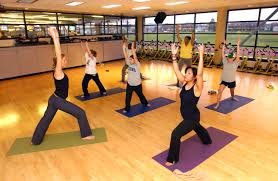aerobic exercise, health and fitness, women exercise, muscle building, weight gain

The prevalence of older adults in the United States is growing at a substantial rate. By 2030, nearly one-fifth of Americans will be in their sixties or older [1], which will have a considerable impact on public health. Numerous epidemiological and clinical studies have established that older adults who participate in regular physical activity are healthier and have a better quality of life than those who are inactive [2, 3, 4]. Regular exercise has also been shown to reduce pain in patients with knee osteoarthritis [5, 6] and to help prevent mechanical low back pain [7]. In contrast, inactivity has been associated with greater pain with injury and has been associated with lower bone density and muscle tone [8]. On the other hand, some aerobic activities, such as running, have been found to result in increased risk for stress or other fractures [9, 10]. Recurring trauma to soft tissue resulting from excessive physical activity conceivably could increase pain and disability [11]. Few studies have addressed the relationship between aerobic exercise and the perception of pain with advancing age.
To study the effect of exercise on disability and pain, our group [10] had investigated the relationship of running and its impact on musculature pain and disability in cohorts of Runners' Association members and community controls and Ever-Runners and Never-Runners who were followed prospectively for six years. In that study, no increase in joint pain or stiffness with age was observed in subjects who exercised often and intensely compared with their more sedentary counterparts. Pain was reduced, however, at all time points by about 25% in the exercising group. In fact, there was a slight decrease in pain for women who exercised over time.
In this investigation, we have extended that research in those cohorts. We have evaluated the association of vigorous physical activity with pain with advancing age after 14 years of follow-up. We hypothesized that those who regularly participated in running or other aerobic activity would report less musculature pain rather than more over the long term than did their inactive counterparts.
*Materials and methods
Subjects
Sample selection and data collection methodology have been detailed previously [10]. Subjects were drawn from two groups: the Fifty-Plus Runners' Association with members across the United States and a Stanford University community-based random sample from the Lipid Research Clinics Study (community controls) which provided access to a sample that was similar in age to the Runners' Association. In this analysis, all subjects with at least two annual questionnaires were included. A total of 961 men and women (538 Runners' Association members and 423 community controls) who met eligibility criteria of being at least 50 years old, had at least a high school education, and used English as their primary language were initially enrolled in 1984. A major re-recruitment effort in 1991 targeted subjects who had dropped out in the first years of the study. To attenuate self-selection bias and exercise effects due to the exercisers among the community controls, we also created groups of Ever-Runners and Never-Runners based on responses to the question at baseline: "Have you ever run for exercise for a period greater than one month?" The study was approved by the Stanford University Investigational Review Board, and each subject gave their informed consent.
Data collection
Each subject completed annual, mailed health assessment questionnaires [12, 13]. The questionnaire includes items on medical history, health status, exercise habits, history of musculature injuries, health care utilization, and demographic variables, such as height and weight, smoking, and alcohol use.
Assessment of physical activity
Physical activity data were obtained from responses to the question: "How many minutes each week do you exercise vigorously (vigorous exercise will cause you to sweat, and your pulse, if taken, will be above 120). Include periods of rapid walking at work and in daily activities." Subjects indicated their participation in running, jogging, swimming, bicycling/stationary bike, aerobic dance/exercises, stair steppers, brisk walking, hiking/treadmill, racket sports, and other.
Assessment of pain
Annually since 1987, pain was assessed using a visual analog scale (VAS) where 0 = no pain and 100 = worst pain. From 1987 through 1989, subjects responded to the question "How bad has pain or stiffness been in the past week?" and marked their response on the VS. In 1987, the VS anchors were: 0 = no pain or stiffness; and 100 = very severe pain or stiffness. In 1988 and 1989, the VS anchors were: 0 = no pain; and 100 = severe pain. Beginning in 1990, a closed-end stem about the presence or absence of pain was added. If the patient affirmed they had pain, then they rated their amount of pain on the VAS. If they responded "No", then their pain score was assigned a value of zero.
*Statistical analysis
Differences between groups at first evaluation (baseline) were compared using chi-square and t-tests. Results are reported as mean (SE) or proportion. Longitudinal data were analyzed using generalized estimating equations (GEE) [14]. Separate analyses were conducted in which repeated measurements were coded by calendar year for questionnaire response and by age. Main-effect predictors were exercise group (Runners' Association/community controls), gender, baseline age, baseline body mass index (BMI; kg/m2), years of education, number of hospital days in the past year, and dichotomous variables for smoking, and history of arthritis, fractures, and cancer at baseline. Baseline values yt= 1987 were defined as weighted means [15],
For all analyses, exercise group and gender were combined to form a four-level classification factor. Two-way interactions of each predictor with this classification factor were also included. To reduce col-linearity, each continuous predictor was dichotomous about its mean. This customization also produced estimates of gender and exercise group main effects that were more meaningful.
Four analytic approaches were employed to help reduce the impact of possible self-selection bias. First, we conducted a separate analysis by Ever-Runner and Never-Runner classification as well as by Runners' Association and community controls groups (from original enrollment). This grouping expanded the cases to include individuals who self-selected to run at an earlier age and who stopped running because of pain or other reasons before entering the study. Second, we used co variate adjustment to account for baseline differences between groups. Direct standardization [16] was used to produce co variate-adjusted mean VAS pain by exercise group and by study year for statistically significant predictors that were identified by the above regression analyses. Data for the community controls group from the first year that VS pain was observed (1987) served as the reference standard. In addition to providing adjustment for differences on excoriates between Runners' Association and community controls groups, use of a standard taken at baseline also permitted adjustment for possible attrition bias. Third, we assessed attrition bias (because any differential attrition between groups could result in a secondary form of self-selection bias) by performing separate analyses limited to study subjects who completed all questionnaires in addition to all subjects (completes versus all). Finally, we used a longitudinal study design in which an adverse stimulus is expected to eventually result in a poor outcome regardless of initial self-selection bias if groups differ sufficiently in exposure to the stimulus. If running creates damage through accumulated trauma, then runners with about ten-fold the amount of exposure to such trauma should have increased pain over time, and any initial differences due to self-selection should narrow as the study progresses.
Results
In 1987, the first year that VS pain was assessed, 811 subjects returned questionnaires (458 Runners' Association members; 353 community controls). The 1991 re-recruitment efforts increased study enrollment to 881 subjects (496 Runners' Association members; 385 community controls). Fifteen subjects were excluded from these analyses because classification data for Ever-Runner versus Never-Runner were not available. Over the study duration, subject retention averaged more than 95% on an annual basis (and 98% of living subjects each year) as shown in Fig. 1. The mean (SE) years of follow up for Runners' Association and community controls were 11.4 (0.17) and 10.1 (0.22) (p < 0.05 for difference), respectively, and for Ever-Runners and Never-Runners it was 11.4 (0.16) and 10.5 (0.25) (p < 0.05 for difference), respectively. Data for this study are based on 866 subjects (492 Runners' Association and 374 community controls), who were also grouped as Ever-Runners (n = 565) and as Never-Runners (n = 301), for whom data were available.
Figure 1
Sample size over time for Runners' Association members and community controls.
Demographic characteristics at the beginning of the study are presented for the four study groups in Table 1. Overall, subjects were similarly well educated, but Runners' Association members and Ever-Runners were statistically younger, had lower BMI and baseline pain scores, ran more miles, exercised more minutes per week, and smoked less (all p < 0.05) relative to community controls and Never-Runners. History of arthritis was lower in Runners' Association members and Ever-Runners than community controls and Never-Runners, but statistically significant only for Ever-Runners versus Never-Runners. In quin tiles of baseline exercise minutes/week, less than a fourth (22%, n = 37) of Ever-Runners and less than a tenth (7%, n = 12) of Runners' Association members were inactive, exercising less than 70 minutes a week (data not shown). In contrast, at the highest quin tile, 88% (n = 155) of Runners' Association members and 91% (n = 159) of the Ever-Runners exercised between 355 and 2,119 minutes/week, indicating that subjects in both of these groups were very physically active. At the end of the study period, the groups had maintained similar levels of exercise minutes/week.
Table 1
Baseline characteristics of study groups
Runners' Association (n = 492)
Community controls (n = 374)
Runners
Ever (n = 565)
Never (n = 301)
Male (%)
83
56
84
50
Mean (SE)
Age (years)
61.6 (0.25)a
65.1 (0.36)
61.7 (0.25)a
65.6 (0.41)
Education (years)
16.6 (0.11)
16.7 (0.13)
16.7 (0.10)
16.5 (0.15)
BMI (kg/m2)
22.9 (0.11)a
24.2 (0.18)
23.0 (0.11)a
24.3 (0.21)
Pain (VS 0–100; 0 = no pain)
20.7 (1.05)a
25.7 (1.27)
20.4 (0.98)a
26.6 (1.44)
Hospital days/past year
0.27 (0.05)
0.34 (0.08)
0.24 (0.05)
0.41(0.09)
Running miles (week)
25.5 (0.65)a
2.1 (0.30)
23.1 (0.64)a
1.06 (0.29)
Exercise minutes (week)
313.6 (9.2)a
123.2 (6.8)
290.8 (8.7)a
119.9 (7.2)
Cigarette (packs/day)
0.02 (0.01)a
0.08 (0.02)
0.01 (0.01)a
0.11 (0.02)
Alcohol (oz./day)
1.08 (0.06)
1.22 (0.06)
1.11 (0.05)
1.22 (0.07)
Subjects (%) with history of
Arthritis
35
41
35*
43
Fractures
53
47
52
48
Cancer
0.002
0.005
0.004
0.003
ap < 0.05 Runners' Association versus community controls or Ever-Runners versus Never-Runners. BMI, body mass index; VAS, visual analog scale.
Baseline demographic characteristics for the two sets of groups by gender are shown in Table 2. For both Runners' Association members and Ever-Runners, the greater majority of subjects were male (approximately 83%), whereas in community controls and Never-Runners the sex ratios were more evenly split (56% and 50%, respectively). In females, Runners' Association members were younger, weighed less, reported less pain, fewer hospital days during the past year, ran more miles and exercised more minutes a week (all p < 0.05) than female community controls. Female Runners' Association members were aerobic.
jpg]( )e
)e
also better educated, smoked less, and drank less alcohol than their community control counterparts (all p > 0.05) and there was a higher proportion of females with a history of arthritis and a lower proportion of females with a history of fractures in the community controls and Never-Runners compared to their counterparts, but these differences were statistically indistinguishable.